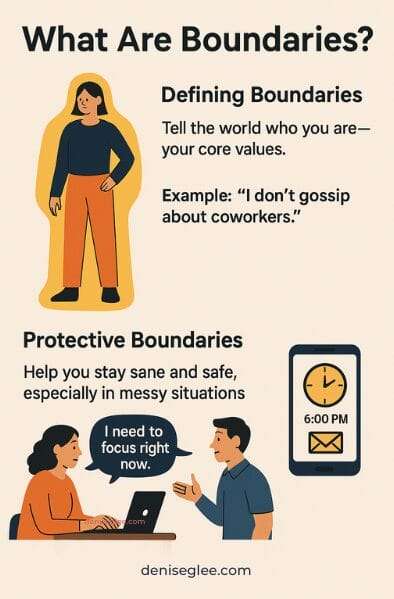
Emotional Boundaries Aren’t Just Self-Care—They’re Survival
- Updated: May 1, 2025
You’ve been told boundaries are about “balance.”
But let’s be real:
For most of us, boundaries are about survival—not snapping at clients just to feel heard, not ghosting relatives just to breathe.
If you’ve ever found yourself shrinking in meetings, over-explaining to a collaborator, filtering your emotions in a relationship, or absorbing someone else’s crisis because you “can handle it”—this is for you.
Emotional boundaries aren’t about being cold.
They’re how you stay clear, steady, and connected to yourself—in your business and your life—when the world keeps asking for more.
In this post, we’ll break down what emotional boundaries really are (hint: they’re not about being unbothered), how to spot when yours are leaking, and how to start protecting your energy without guilt, collapse, or disconnection.
Let’s go there.
What You’ll Learn About Emotional Boundaries
What Are Emotional Boundaries?

A lot of people think emotional boundaries are about saying, “I don’t want to talk about that,” or “Don’t trigger me.” But that’s only a piece of the story. Real emotional boundaries are more internal than external—they’re the filters and fences you carry inside that help you stay grounded, even when life gets messy.
Dr. John Townsend, co-author of Boundaries and Beyond Boundaries, describes two categories of boundaries: defining and protective. Emotional boundaries fit in both.
Defining boundaries are the core of who you are—your emotional identity. They say, “I know what I feel, and I don’t need you to manage or fix it for me.”
Protective boundaries are flexible—they help you guard your emotional energy, especially when someone is intrusive, manipulative, or emotionally chaotic.
✦ In Personal Life
Let’s say your friend is going through something heavy, and they start trauma-dumping every time you talk. Instead of absorbing their pain or ghosting them, emotional boundaries sound like:
→ “I care about you, but I can’t be your only outlet. Can we talk about lighter things today?”
That’s not rejection—it’s regulation.
✦ At Work
Imagine your team member sends you a frantic message every time something goes wrong—even if it’s not your responsibility. Without boundaries, you might drop everything to fix it, leaving your own priorities behind. With emotional boundaries, you can respond:
→ “I hear your frustration. Let’s regroup at our 2pm check-in.”
That’s leadership with limits.
The image below highlights the differences between these types of boundaries. Now that you understand what emotional boundaries are, let’s talk about why they matter so much—both personally and professionally.

The Importance of Emotional Boundaries
Emotional boundaries are the invisible lines that separate your thoughts, feelings, and needs from someone else’s. They’re not about shutting people out—they’re about honoring your emotional reality without merging it with someone else’s mood, dysfunction, or denial.

When we weren’t raised with healthy emotional boundaries, we often take on other people’s emotions as our own. We try to fix, please, or over-function to keep the peace. And when others don’t validate our feelings? It can feel like we’re unraveling inside.
This is more common than we think—especially for those raised by emotionally immature or inconsistent caregivers. Without emotional boundaries, we end up feeling responsible for how others feel, and ashamed for needing anything ourselves. That’s not empathy. That’s emotional enmeshment.
Every time I hear someone say, “They don’t care how I feel,” I’m often hearing the voice of someone who was trained to take ownership of other people’s feelings—just to stay safe.
Denise G. Lee Tweet
Why Emotional Boundaries Matter—At Home and at Work
When we don’t have emotional boundaries, it shows up everywhere:
At home, we become the “go-to” fixer, constantly absorbing drama and guilt.
At work, we become the over-functioning leader who can’t say no without apologizing.
Dr. John Townsend explains in Beyond Boundaries that ownership is a key part of emotional maturity. Your thoughts, your feelings, and your limits are your responsibility. Not to justify, not to explain away—but to own. This is what helps you show up for others without abandoning yourself.
In business especially, emotional boundaries matter more than ever. If you’re leading a team, working with clients, or serving a public audience, you need internal filters that help you:
Show empathy without absorbing chaos
Stay open without becoming emotionally depleted
Take feedback without questioning your identity
This isn’t about being “too sensitive” or “too tough.” It’s about knowing where you end and someone else begins.
Signs You’ve Crossed Emotional Boundaries
Let’s talk about what crossing emotional boundaries really looks like—because it’s not always obvious.
Take this moment from the sitcom Friends: Ross opens up to Chandler about insecurities in his new relationship. Instead of listening, Chandler rolls his eyes and says, “Oh, poor Ross, what’s new? You’re always freaking out about something.” Classic sitcom sarcasm—but a clear emotional boundary fail.
Ross expressed vulnerability. Chandler minimized it. That dynamic might’ve been played for laughs, but in real life? It stings. A lot.
Most of us have experienced some version of that. And if we grew up with emotionally immature caregivers, we likely learned to either dismiss our feelings quickly or take on everyone else’s as our own—just to avoid conflict or rejection.
Sometimes it’s not even intentional. We were trained with life scripts like “Don’t think,” “Don’t feel,” or “Make everyone else okay first.” That’s how emotional boundaries get blurred. You may think you’re being helpful—but you’re actually protecting someone from the consequences of their own discomfort.
When someone shares a feeling and we rush to fix it, minimize it, or hijack the conversation with our own story—we’ve crossed into their emotional territory.
Denise G Lee Tweet
The Quiet Ways We Cross Our Own Boundaries—Without Realizing It
Here are subtle signs you may be crossing or ignoring emotional boundaries:
You absorb someone’s stress or sadness and feel responsible for fixing it
You second-guess your own needs because someone else might get upset
You feel like saying “no” makes you a bad person
You feel guilty when others are upset, even if it has nothing to do with you
This isn’t about becoming cold or detached. It’s about learning to stay grounded in your own emotional reality—without micromanaging someone else’s.
Emotional Overload Isn’t Empathy—It’s a Sign Your Boundaries Are Blurry
Do you see yourself in any of those examples? Maybe one… maybe all?
If so, take a deep breath—this isn’t about shame. Just like you learned how to talk or tie your shoes, you can relearn how to name your feelings and speak your needs. Emotional boundaries are a skill, not a personality trait.
Noticing the signs is the first win. It means your awareness is waking up—and that’s the starting line for real change.
In the next section, we’ll talk about how to reclaim your right to set healthy emotional boundaries—without slipping into victimhood, blame, or over-functioning. You don’t have to choose between being kind and being clear. You can be both.
What is the point of having someone who only likes the people-pleasing version of you? How can they help you if they don't know who you really are?
Denise G. Lee Tweet
Practical Steps to Establish Healthy Emotional Boundaries
Like anything else, boundaries are a skill—you get better with practice. But if you’ve spent years being the fixer, the over-giver, or the one who disappears into people-pleasing, it can be hard to remember you can set emotional boundaries.
These four steps will help you stay grounded, connected, and clear—without slipping into old patterns of blame, enabling, or self-abandonment.
Step One: Identify Your Triggers
Many of us run on autopilot when something makes us feel anxious, overwhelmed, or off. But our discomfort is a clue—not a nuisance. Pay attention to what leaves you feeling emotionally tangled or drained.
Here are a few signs your boundaries are being crossed:
You routinely ignore your own needs to keep the peace.
You feel a lingering heaviness or anxiety after certain conversations.
You feel wiped out or “off” after interacting with specific people or being in certain places.
Your body starts screaming—tight shoulders, headaches, stomach knots.
You reach for comfort food, alcohol, or screen time to numb out after stressful interactions. This is called self-medicating—a short-term fix that often creates long-term problems.
👉 Learn more about it here.
These reactions aren’t random. They’re your system asking you to pay attention. Start there.
Oftentimes, the reason why we tolerate the misbehavior of others is because they remind us of family members or valued mentors who initially created those painful, unresolved experiences.
Denise G. Lee Tweet
Step Two: Explore the Roots
Boundary issues are rarely just about the present moment—they’re echoes from the past. If setting boundaries feels hard, ask yourself: When did it first feel unsafe to say no? Who taught me that my comfort doesn’t matter?
As John Bowlby’s Attachment Theory explains, we’re wired to recreate familiar dynamics—even the unhealthy ones—until we consciously interrupt the pattern.
Here’s the good news: you don’t have to do that alone. Working with a coach, therapist, or even a truth-telling friend can help you untangle those root issues. Emotional boundaries don’t mean cutting people off; they mean learning to protect your peace without abandoning your power.
Step Three: Clarify What You Actually Want
If you’re not clear about what you truly want, it’s easy to end up living for someone else’s comfort—or approval. That’s not clarity. That’s survival mode.
Take time to identify your actual needs—not the people-pleasing version. Ask yourself:
✨ What do I want? What helps me feel whole?
Because here’s the truth:
What’s the point of having people in your life who only like the version of you that never disagrees, never says no, and never asks for anything real?
If you’ve experienced childhood trauma, your need for safety and validation might be all tangled up. I once had a client who said he wanted to earn more money for his family. On the surface, it looked like a goal rooted in love—but underneath, it was an attempt to heal his own unmet emotional needs. What he really needed was deeper connection and the confidence to parent from presence, not pressure.
If you’ve done that, you’re not broken—you’ve just been surviving the only way you knew how.
I touched on this in a recent social post. Click the link below to join the conversation.
Too many people are making SERIOUS, long-term decisions based on fickle, short-term reactions. And the cost is especially true for trauma survivors, here's why:
— Denise G. Lee (@DeniseGLee) December 20, 2024
When you've endured trauma, your brain is wired to prioritize safety. This means in moments of stress or uncertainty,…
Step Four: Speak Clearly and Confidently
This is the part where everything clicks into action. It’s not just about knowing what you need—it’s about saying it out loud, with clarity and confidence.
If you’ve been around aggressive, dismissive, or manipulative personalities, speaking up might feel dangerous—or even selfish. But honoring your boundaries isn’t rude. It’s responsible. You’re allowed to say “no,” to pause a conversation, or to ask for space—without explaining yourself to exhaustion.
Assertive communication isn’t about confrontation. It’s about owning your truth without shrinking or over-explaining. You can be kind and clear. You can be honest and direct.
Here’s your reminder: saying what you mean, calmly and clearly, is a form of self-respect.
The image below summarizes these healthy emotional boundary communication tips. Next, I will share my final thoughts.

FAQ: Setting Emotional Boundaries Without Guilt
Final Thoughts
If you’ve read this far, you already know:
This isn’t just about boundaries.
It’s about liberation.
It’s about no longer sacrificing your emotional well-being on the altar of politeness.
It’s about protecting your clarity—not just your time.
Before we wrap out this convo about emotional boundaries, know this:
You don’t need to explain—they already know what they’re doing.
Resist the need to justify—you run your business this way for a reason.
Refuse the desire to soften yourself —being invisible isn’t the same as being taken seriously.
Emotional boundaries aren’t rude.
They’re revolutionary.
They’re how you stop bleeding your energy into people who profit from your self-abandonment.
If this post stirred something in you, I’d love to hear what landed.
👉 Write me a note
If you’re tired of guessing where your line is—or ready to stop shrinking just to keep the peace:
💛 Work with me – I’ll help you rebuild your self-trust and lead from grounded emotional authority.
And for more truth, tools, and no-BS healing:
🎧 Listen to the podcast
This isn’t about perfection.
It’s about finally being honest about what you need—and brave enough to honor it.
You’re not too much.
You’re just done pretending.





